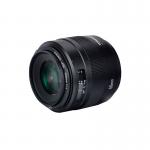Reviews
THE standard normal lens
The standard lens (at least with KB 35mm/full format, a little longer with APS-C sensors), it presents itself small and fine. And with 1:1.4 the cheapest 'light giant'. 50 mm are essentially suitable for landscape torso or portrait format for full-body shots. It is not quite as suitable for close-up facial portraits, as it leads to slight visible distortions. However, the greater the distance to the subject, the less noticeable this is. But don't get bogged down by that, generations before zoom (vario lenses) came out with 50mm photographed everything; and it's still the default. With a fixed focal length, however, you are forced to deal a little more with the subject and to compose the image a little more intensively. Since you can't just zoom in, you have to move a bit to get the subject in the viewfinder. Fixed focal lengths are unbeatable in terms of light intensity, but this light intensity cannot be used with every subject. In principle, prime lenses are weaker in terms of resolution, sharpness and chromatic aberrations at their widest aperture (f/1.4). Therefore, if you want absolute quality, you should stop down. And the lens is really good from f/4 and it peaks at f/5.6. The edges do not increase as much as the center and the extended center, but unless your main motif is on the edge, this is absolutely justifiable and usually not even recognizable. However, chromatic aberrations can only be minimally reduced by stopping down. But the 50's is relatively uncritical here. In contrast, in situations with little light, the open aperture of 1:1.4 can be used, since resolution, contrast and chromatic aberration do not appear so seriously in such ambient light. It has a metal mount (unlike the 1.8 II version which uses plastic, the new 50mm f/1.8 STM has a metal mount again) and eight aperture blades (important for nice round shapes in bokeh). Micro USM (no ring USM that would be even faster) with FTM (full time manual, you can set it manually at any time), which in itself is not common and, to my knowledge, it is the only one in this form. That means e.g. B. In contrast to all other USM and STM motors, it is minimally louder and minimally slower. Still a "light giant" with a speed of f:1.4. When focusing, the inner "tube" extends up to 9mm, I don't find that a problem, especially when the lens hood is on it. Fortunately, the front lens does not rotate (this means that polarizing filters can be used without hindrance, even with a lens hood, as this is wide enough to rotate the filter with your index finger) and the lens hood also remains in place. As usual, the ES-71II lens hood has to be purchased separately since it is not an L lens. If necessary, a quiver LHP-C10, and another ES-C9 leather pouch which is more like a quiver or a leather pouch of the newer type LP1014 can be used. But it's worth it, the lens hood ES-71II is extremely stable and has taken note of the impact I've already had on concrete without complaint. You won't find a better quality system for the Canon system in this price range. The 50mm 1.2, which is only about 1/3 aperture stronger, is almost four times as expensive and only conditionally better, but it has considerable chromatic aberration, is very blurry in the edge area and even stopped down, it does not reach the level of the 1.4' first However, it is an L lens and therefore completely different in terms of manufacturing quality, dust and splash-proof, etc. But for the price! It's fun for me to just go out with a lens and see what's coming up and then just deal with the composition. For portraits with a beautiful bokeh, aperture 1.4 is the best anyway.
20/02/2023

